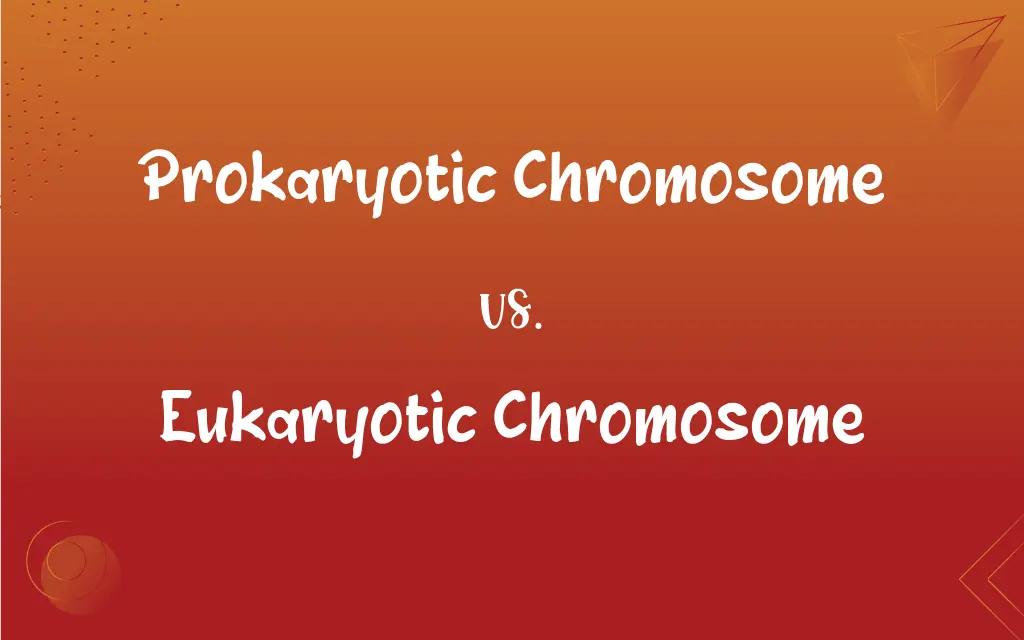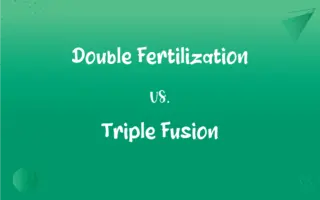Prokaryotic Chromosome vs. Eukaryotic Chromosome: What's the Difference?
Edited by Janet White || By Harlon Moss || Updated on October 28, 2023
Prokaryotic chromosomes are circular and found in the nucleoid; eukaryotic chromosomes are linear and located in the nucleus.

Key Differences
In the realm of biology, understanding the difference between prokaryotic chromosome and eukaryotic chromosome is fundamental. A prokaryotic chromosome is typically a singular, circular piece of DNA found in the nucleoid region of the cell. On the other hand, eukaryotic chromosomes are multiple and linear, housed within the nucleus of the cell.
Diving deeper into the structure, a prokaryotic chromosome lacks the complex wrapping and organization seen in its eukaryotic counterpart. The prokaryotic chromosome is more straightforward, being a continuous loop of DNA. Conversely, a eukaryotic chromosome is wrapped around proteins called histones, which further compact to form chromatin structures, giving them a more intricate organization.
Replication processes between a prokaryotic chromosome and eukaryotic chromosome also differ. The prokaryotic chromosome replicates in a simple manner, beginning at a specific point and proceeding until the entire loop is duplicated. In contrast, eukaryotic chromosomes require a more complex replication mechanism, with multiple origins of replication due to their longer length and structure.
Regarding genetic information, the prokaryotic chromosome holds most of the essential genes the organism needs for survival. The eukaryotic chromosomes, on the other hand, contain a mix of essential genes, regulatory elements, and non-coding regions, showcasing a more complex genomic landscape.
While the prokaryotic chromosome is mostly devoid of associated proteins, the eukaryotic chromosome heavily relies on histones for structure and regulation. This difference in protein interaction further underscores the distinction in complexity and organization between prokaryotic and eukaryotic chromosomes.
ADVERTISEMENT
Comparison Chart
Structure
Circular
Linear
Location
Nucleoid
Nucleus
Number in Typical Cell
One
Multiple
Associated Proteins
Few to none
Histones
Replication Mechanism
Simple, starts at a specific point
Complex, with multiple origins of replication
ADVERTISEMENT
Prokaryotic Chromosome and Eukaryotic Chromosome Definitions
Prokaryotic Chromosome
A non-histone associated DNA sequence in prokaryotic organisms.
Unlike eukaryotes, the prokaryotic chromosome doesn't rely heavily on proteins for its structure.
Eukaryotic Chromosome
Complex DNA-protein complexes responsible for storing genetic information in eukaryotic organisms.
Scientists study the eukaryotic chromosome to understand genetics and inheritance patterns.
Prokaryotic Chromosome
The blueprint of life for prokaryotic cells, carrying vital information for their survival and functioning.
Any damage to the prokaryotic chromosome can hinder the cell's ability to function properly.
Eukaryotic Chromosome
Multiple genetic units in eukaryotes, housing both coding and non-coding regions.
The eukaryotic chromosome contains genes, introns, and regulatory sequences.
Prokaryotic Chromosome
A singular DNA molecule responsible for most of the genetic coding in prokaryotes.
Genetic mutations in the prokaryotic chromosome can lead to antibiotic resistance in certain bacteria.
Eukaryotic Chromosome
The genetic carriers of eukaryotic cells, ensuring inheritance and cellular functions.
Alterations in the eukaryotic chromosome can lead to genetic disorders.
Prokaryotic Chromosome
A circular DNA structure found within the nucleoid of prokaryotic cells.
Bacteria contain a prokaryotic chromosome that houses their genetic information.
Eukaryotic Chromosome
DNA structures wrapped around histone proteins, forming chromatin in eukaryotes.
The eukaryotic chromosome becomes highly condensed during cell division.
Prokaryotic Chromosome
The primary genetic material in prokaryotes, devoid of a surrounding membrane.
The prokaryotic chromosome is not enclosed within a distinct nucleus, unlike eukaryotic cells.
Eukaryotic Chromosome
Linear DNA molecules located within the nucleus of eukaryotic cells.
Human cells contain 23 pairs of eukaryotic chromosomes.
FAQs
What is the shape of a prokaryotic chromosome?
Prokaryotic chromosomes are typically circular.
Are eukaryotic chromosomes more complex than prokaryotic chromosomes?
Yes, eukaryotic chromosomes are more complex, having a mix of genes, regulatory elements, and non-coding regions.
How are prokaryotic chromosomes visualized in research?
They can be visualized using techniques like electron microscopy.
How does the replication of a eukaryotic chromosome differ from a prokaryotic chromosome?
Eukaryotic chromosome replication is more complex with multiple origins, while prokaryotic replication is simpler, starting at a specific point.
Do prokaryotic chromosomes have introns?
Generally, prokaryotic chromosomes do not have introns.
Do eukaryotic chromosomes have a centromere?
Yes, eukaryotic chromosomes have a centromere, essential for cell division.
How do eukaryotic chromosomes change during cell division?
Eukaryotic chromosomes condense and become visible as distinct structures during cell division.
Are prokaryotic chromosomes protected by a nuclear envelope?
No, prokaryotic chromosomes are found in the nucleoid, without a surrounding nuclear envelope.
How is gene expression regulated differently between prokaryotic chromosomes and eukaryotic chromosomes?
Prokaryotic gene expression often involves operons, while eukaryotic chromosomes utilize a more complex system with enhancers, silencers, and other regulatory elements.
What proteins are associated with the eukaryotic chromosome?
Eukaryotic chromosomes are associated with histone proteins.
What type of organisms have prokaryotic chromosomes?
Organisms like bacteria and archaea have prokaryotic chromosomes.
How many eukaryotic chromosomes do humans have?
Humans have 46 eukaryotic chromosomes, or 23 pairs.
What's the main function of the prokaryotic chromosome?
The prokaryotic chromosome carries the essential genes needed for the organism's survival and function.
What role do telomeres play in eukaryotic chromosomes?
Telomeres are protective end caps on eukaryotic chromosomes, ensuring chromosome stability and limiting the number of cell divisions.
Where are eukaryotic chromosomes found?
Eukaryotic chromosomes are located in the nucleus.
Is the prokaryotic chromosome wrapped around histones?
No, the prokaryotic chromosome is not wrapped around histones.
Can changes in the eukaryotic chromosome lead to diseases?
Yes, alterations or mutations in eukaryotic chromosomes can result in genetic disorders.
How many prokaryotic chromosomes does a typical bacterial cell have?
A typical bacterial cell usually has one prokaryotic chromosome.
Are eukaryotic chromosomes always linear?
Yes, eukaryotic chromosomes are typically linear.
Can prokaryotic chromosomes be plasmids?
While prokaryotic cells can contain plasmids, they are separate from the primary prokaryotic chromosome.
About Author
Written by
Harlon MossHarlon is a seasoned quality moderator and accomplished content writer for Difference Wiki. An alumnus of the prestigious University of California, he earned his degree in Computer Science. Leveraging his academic background, Harlon brings a meticulous and informed perspective to his work, ensuring content accuracy and excellence.
Edited by
Janet WhiteJanet White has been an esteemed writer and blogger for Difference Wiki. Holding a Master's degree in Science and Medical Journalism from the prestigious Boston University, she has consistently demonstrated her expertise and passion for her field. When she's not immersed in her work, Janet relishes her time exercising, delving into a good book, and cherishing moments with friends and family.































































